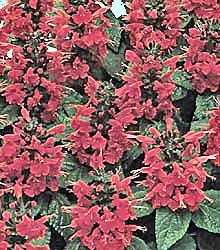
Red Sage
Red Sage is a perennial in warm climates but acts as an annual in areas that can stay below freezing for more than a few hours at a time. It grows to 3 feet in height in the southeast U.S. and down into Central America. Red Sage biological name is Salvia officinalis Labiateae.
Red sage is used in garden borders where brilliant color and attraction to butterflies and hummingbirds is desired. Another name for this plant is "Lady in Red." After initial seeding the plant will re-seed itself in following years.
It is the classic remedy for inflammations of the mouth, throat and tonsils, its volatile oils soothing the mucous membranes. Used as a mouth wash for inflamed and bleeding gums (gingivitis), inflamed tongue (glossitis) or generalized mouth inflammation (stomatitis). An excellent remedy in mouth ulcers (apthae).
As a gargle it will aid in the treatment of laryngitis, pharyngitis, tonsillitis and quinsy. A valuable carminative used in dyspepsia. It reduces sweating when taken internally and may be used to reduce the production of breast milk. As a compress it promotes the healing of wounds. Red Sage stimulates the muscles of the uterus and so should be avoided during pregnancy. Jethro Kloss calls sage an almost "cure-all - you could never go amiss if you take sage."
Combinations : As a gargle for throat conditions it combines well with Tormentil and Balm of Gilead. In dyspepsia it can be combined with Meadowsweet and Chamomile.
Red Sage Active Compounds
Volatile oil, containing a and b-thujone as the major components, with cineole, borneol, camphor, 2-methyl-3-methylene-5-heptene and others.
Diterpene Bitters. picrosalvin (carnosol), carnosolic acid and others. Flavonoids. salvigenin, genkwanin, 6-methoxygendwanin, hispidulin, luteolin. Phenolic acids; rosmarinic, caffeic, labiatic etc. Salviatannin, a condensed catechin.
Red Sage Remerdies For
- Carminative, anti-spasmodic, anti-microbial, astringent
- anti-inflammatory, sudorific, expectorant, tonic, aromatic
- nervine, vermifuge, emmenagogue, diuretic, stimulant
- diaphoretic, stomachic, antiseptic.